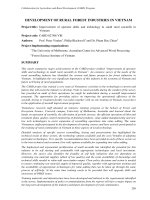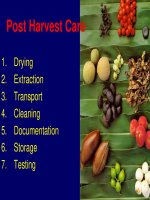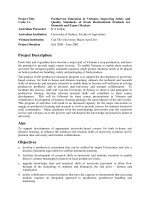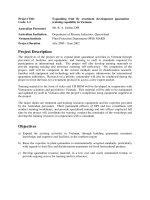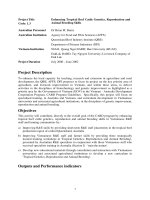Báo cáo nghiên cứu nông nghiệp " Forest Tree Seed –definitions and concepts " pot
Bạn đang xem bản rút gọn của tài liệu. Xem và tải ngay bản đầy đủ của tài liệu tại đây (1.13 MB, 30 trang )
1
Forest Tree Seed
– definitions and concepts
2
Concepts to define – 1
1. Provenance
2. Race
3. Land Race
4. Family
5. Seedlot
6. Genetic gain
3
1. Provenance
• Place where seed was collected
• Refers to natural forests, not plantations
• Provenance boundaries not always well
defined
• Provenances may have different genetic
adaptation
4
1. Provenance
• Example – E. camaldulensis
5
2. Race
• Subdivision of a species, with genetically
similar individuals.
• Sometimes synonymous with provenance.
• Races separated using observed differences.
• For example, wood basic density, bark
thickness, and flowering patterns have been
used to define E. globulus races
6
3. Land Race
• Introduced trees that are adapted to an
environment after several generations.
7
3. Land Race
• Introduced trees that are adapted to
an environment after several
generations.
• Advantage:
Selection may help land races adapt
to a new environment.
8
3. Land Race
• Introduced trees that are adapted to an
environment after several generations.
• Advantage:
Natural selection helps land races adapt to a
new environment.
• Disadvantages:
May not be from the best natural provenances,
and/or may come from very small genetic
base.
9
4. Family
• Individuals with parents in common.
10
4. Family
• Individuals with parents in common.
• Half-sib family:
One parent in common (mother for trees).
Father is unknown, through natural pollination.
11
4. Family
• Individuals with parents in common.
• Half-sib family:
One parent in common (mother for trees).
Father is unknown, through natural pollination.
• Full-sib family:
Both parents in common.
Generated by controlled (artificial) pollination.
12
4. Family
• Individuals with parents in common.
• Half-sib family:
One parent in common (mother for trees).
Father is unknown, through natural pollination.
• Full-sib family:
Both parents in common.
Generated by controlled (artificial) pollination.
• Progeny:
Trees produced from seed of a known parent.
13
4. Family
• SINGLE TREE COLLECTION
seed collected from 1 mother tree
(i.e. progeny will be a half-sib family)
14
4. Family
• SINGLE TREE COLLECTION
seed collected from 1 mother tree
(i.e. progeny will be a half-sib family)
• Half-sib family:
One parent in common (mother for trees).
Father is unknown, through natural pollination.
• Progeny:
Trees produced from seed of a known parent.
15
5. Seedlot
• Collection from a stand in one location
at ONE POINT IN TIME
• Reference number – links to seed
collection information, storage, dispatch
etc.
• Can be a “bulk” or a group of single tree
collections from the 1 stand, or both
(“Bulk” = seed from >1 parent)
16
5. Seedlot code
• For a bulk seedlot to be
REPRESENTATIVE of a provenance,
should have 10-15 parents (or more)
equally represented
17
6. Genetic gain
Gain ƒ ( i h
2
σ
p
)
Where:
σ
p
→ variability
h
2
→ genetic control
i
→
selection intensity
18
Concepts to define – 2
7. Orthodox Seed
8. Unorthodox Seed
9. Recalcitrant Seed
19
7. Orthodox Seed
• Seeds can be dried down to low
moisture content (5%)
& successfully stored at low
temperatures for long periods
20
8. Unorthodox Seed
• Seed that is not orthordox
Îcan not be dried down to low moisture
content (5%)
Îcan not be successfully stored at low
temperatures for long periods
21
9. Recalcitrant Seed
• Unable to tolerate more than a limited
amount of desiccation
e.g. can not be stored with moisture
content in equilibrium at 20
o
C with
about 96-98% relative humidity
22
Grevillea robusta over tea in Sri
Lanka
23
Seed drying in sun
(what type of seed ?)
24
10. Seed Stand
• High quality stand
• Natural stand OR Plantation
• Modified (thinning) to enhance seed
production
• If plantation – prefer to know its ORIGIN
25
11. Seed Production Area
• Area established with objective of seed production
• Established with seed from KNOWN superior
source(s)
– more than 40 parents
(>40 single tree collections bulked together)
• Managed for abundant production of high seed
– careful selection of superior trees
– heavy early thinning


